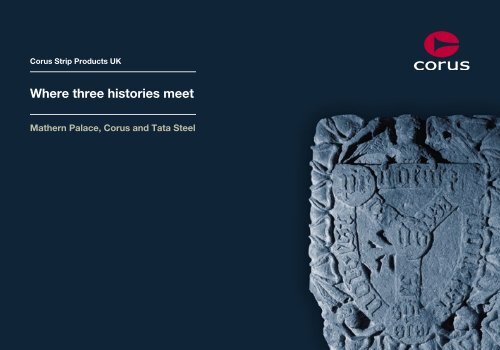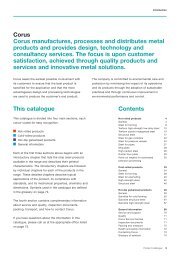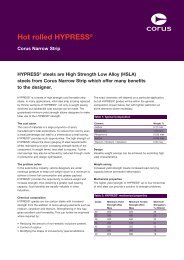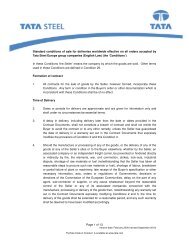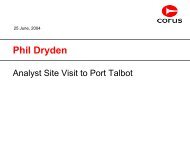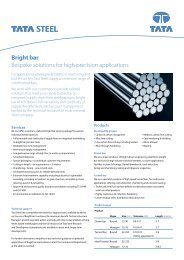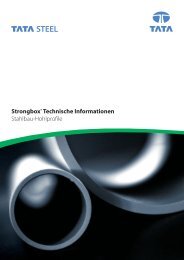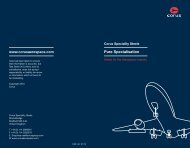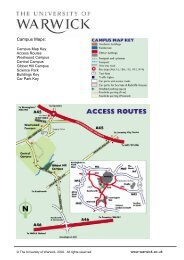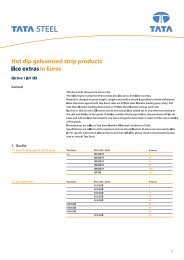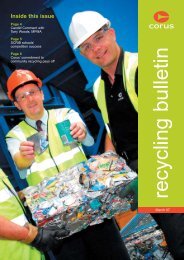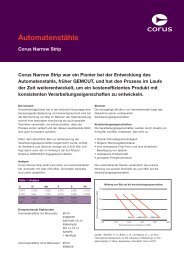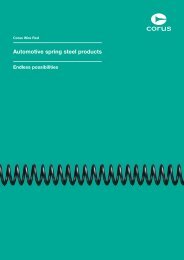Corus 100yr brochure.indd - Tata Steel
Corus 100yr brochure.indd - Tata Steel
Corus 100yr brochure.indd - Tata Steel
Create successful ePaper yourself
Turn your PDF publications into a flip-book with our unique Google optimized e-Paper software.
<strong>Corus</strong> Strip Products UK<br />
Where three histories meet<br />
Mathern Palace, <strong>Corus</strong> and <strong>Tata</strong> <strong>Steel</strong>
Places in time<br />
Mathern Palace near Chepstow in South Wales<br />
is an engaging and complex building, full of<br />
character that reflects its long history.<br />
As with many such buildings, its history is very much<br />
about the history of its owners. This booklet looks briefly<br />
at the history of Mathern Palace and follows the thread<br />
of its ownership to its current owners, <strong>Corus</strong>. From there<br />
we tell a wider story about ownership of businesses and<br />
a shared history that affects local communities in South<br />
Wales and in India.<br />
<strong>Corus</strong> Strip Products UK is part of <strong>Corus</strong>, an international<br />
steel company acquired recently by <strong>Tata</strong> <strong>Steel</strong> of India.<br />
The three works in the <strong>Corus</strong> Strip Products UK business,<br />
all in South Wales, are Llanwern Works in Newport, Port<br />
Talbot Works in the town of that name, and Aluminised<br />
Products at Pontardulais in Swansea.<br />
Llanwern Works is only 17 miles from Mathern Palace.<br />
However, the connection between Mathern Palace and<br />
<strong>Corus</strong> takes us back 50 years and 50 miles down the road<br />
from Llanwern. There lies Port Talbot, the main works in<br />
the business and the link between Mathern Palace and<br />
<strong>Corus</strong>. We shall let you discover that link for yourself in<br />
the short histories that follow, and the similarities between<br />
two recently joined businesses in South Wales and India.<br />
Front cover: This stone, called the Trinity Stone, once adorned the gateway of Mathern Palace. The date of the stone is 1419, but it was first noticed at the Palace in 1776. The stone teaches the doctrine<br />
of the Holy Trinity. Such stones are common inside churches, but this is the only known example of one that was fixed to a secular building, although it is appropriate that the building was an episcopal residence.<br />
Information about the Trinity Stone is from A History of the Parish of Mathern, by E. T. Davies, published by The Chepstow Society, 1950. The Trinity Stone is now held at the National Museum of Wales, although<br />
when this <strong>brochure</strong> was produced, the stone was available for viewing by appointment only.<br />
2
4<br />
THE PLACE OF A KING.<br />
In 1957 the Palace was purchased by<br />
Richard Thomas & Baldwins Limited<br />
as a guesthouse, becoming the property<br />
of the British <strong>Steel</strong> Corporation...
Mathern Palace<br />
In the seventh century, the Bishops of Llandaff acquired lands in Mathern<br />
Parish from Meurig ap Tewdric, son of Tewdric King of Glamorgan. Tewdric<br />
was killed in battle and buried in the nearby church, which bears his name.<br />
‘Mathern’ is from the Welsh elements ‘Ma’ and ‘Teyrn’, meaning ‘the place<br />
of a king’.<br />
Mathern Palace was the official home of the Bishops of<br />
Llandaff from 1333 until 1709. In 1794 the Palace and<br />
lands were let for farming, firstly by the incumbent Bishop<br />
and later by the ecclesiastical commissioners.<br />
The building passed into private ownership in 1894 and<br />
was restored and improved by H.A. Tipping, an historian,<br />
who was also responsible for the layout of the delightful<br />
gardens.<br />
In 1957 the Palace was purchased by Richard Thomas &<br />
Baldwins Limited as a guesthouse, becoming the property<br />
of the British <strong>Steel</strong> Corporation when the steel industry<br />
was nationalised, then British <strong>Steel</strong> plc upon privatisation,<br />
and now <strong>Corus</strong>.<br />
Surrounded by H. A. Tipping’s gardens, Mathern Palace<br />
is approached through the remains of an early 15th<br />
century gateway.<br />
The central block of the building, which faces northeast,<br />
consists of a tower of three storeys containing the main<br />
entrance and a block of two storeys containing the long<br />
parlour; an east wing projects forward of the central<br />
block, and a west wing projects to the rear. A third wing<br />
projecting east in line with the central block was added<br />
after 1894.<br />
The niche over the porch probably contained a statue of<br />
the Blessed Virgin Mary, a figure that could not have been<br />
displayed after the death of Henry VIII in 1547, which<br />
confirms a pre-Reformation date for this part of<br />
the building.<br />
The inner tower, which includes the entrance hall and<br />
rooms above, could date from the 13th or 14th century,<br />
as could the central two-light window in the west wing<br />
(most likely the original chapel).<br />
The dining room and its doorway, and the long parlour,<br />
are 16th century, as is the fireplace in the second<br />
bedroom above the parlour.<br />
5
Parallel paths<br />
<strong>Corus</strong> Strip Products<br />
UK and <strong>Tata</strong> <strong>Steel</strong> each<br />
have a works that has<br />
been operating for a<br />
century: Port Talbot<br />
in South Wales and<br />
Jamshedpur in India.<br />
And that is not all they have in common. During their<br />
history, both have undergone programmes to improve<br />
the performance of their businesses by changing the<br />
culture within. They share a strong dedication to their<br />
employees and to the communities that surround their<br />
works. Looking at their history and, in particular, at<br />
their activities in the community, a similar business<br />
philosophy is evident.<br />
<strong>Corus</strong> Strip Products UK<br />
The origins of Port Talbot<br />
Works go back to 1253, when<br />
locally mined ores were worked<br />
in small, stone-built charcoalfuelled<br />
furnaces under the<br />
auspices of the monks in<br />
nearby Margam Abbey.<br />
This continued until 1717,<br />
when the first Baron Mansel<br />
of Margam set up the Afan<br />
Forge at Margam.<br />
Port Talbot<br />
In the 19th century, locals recognised that the area<br />
needed a better port. Opened in 1837, Port Talbot dock was<br />
named after its principal sponsor, Christopher Rice Mansel<br />
Talbot of Margam. The dock was enlarged and enhanced<br />
over the years and was the basis for the development of<br />
metal working in the area.<br />
The low-cost bulk steelmaking techniques pioneered by<br />
Bessemer and Siemens in the late 1800s revolutionised the<br />
industry. At the same time, new uses for steel greatly<br />
increased demand.<br />
In 1901, work began on the construction of the first Port<br />
Talbot steel works when the Port Talbot Iron and <strong>Steel</strong><br />
Company Limited was formed.<br />
6
Port Talbot Works today<br />
Later, in 1906, Baldwins Limited acquired the works and<br />
began erecting two blast furnaces in 1916 at a new site<br />
called Margam Works just a half mile away. A further<br />
merger in 1930 ultimately created Guest, Keen, Baldwins<br />
Iron & <strong>Steel</strong> Company Limited. A third blast furnace was<br />
completed in 1941.<br />
Further amalgamations of the industry after the war led to<br />
The <strong>Steel</strong> Company of Wales Limited on 1st May 1947. This<br />
company reconstructed and expanded Port Talbot and<br />
Margam, adding the Abbey Melting Shop, a slabbing mill,<br />
hot strip mill and cold mill, which all began operating in<br />
1951. By 1960, the Works had added blast furnaces 4<br />
and 5.<br />
The Labour Government elected in 1964 decided to<br />
re-nationalise Britain’s steel industry—publicly owned<br />
between 1951 and 1957—and created the British <strong>Steel</strong><br />
Corporation in 1967. In 1970, H.M. The Queen, formally<br />
opened a Basic Oxygen <strong>Steel</strong>making plant and a new<br />
tidal harbour.<br />
After the difficult years of the 1970s and early 1980s, the<br />
construction of the Morfa Coke ovens and the major hotstrip<br />
mill refurbishment initiated a period of consolidation.<br />
During the next decade, Port Talbot Works became one<br />
of the most efficient steel plants in the world. But in 1988,<br />
the British <strong>Steel</strong> Corporation was taken back into private<br />
hands, emerging as British <strong>Steel</strong> plc.<br />
Blast furnace 4 was rebuilt in 1992 and a new continuous<br />
annealing processing line was opened in 1999. In the<br />
same year, British <strong>Steel</strong> plc merged with Koninklijke<br />
Hoogovens, a Dutch steel and aluminium producer,<br />
to form <strong>Corus</strong>, a truly international metals company.<br />
A third caster was added in 2005 and there were<br />
significant heavy-end developments in 2003-2006.<br />
Today, 3600 employees produce some 4.7 million<br />
tonnes of steel a year, roll about three million tonnes<br />
of it themselves and send the rest to Llanwern to roll.<br />
7
<strong>Corus</strong> Strip Products UK<br />
1 2 3<br />
4<br />
1, 2: Early images of Llanwern Works 3: Llanwern Works today 4: The Aluminised Products Works at Pontardulais<br />
Llanwern<br />
The idea for another site arose in 1955 when the need for a<br />
fully-integrated iron and steel works and rolling mill became<br />
clear. The government asked Richard Thomas & Baldwins<br />
Limited, part of the <strong>Steel</strong> Company of Wales, to look at<br />
locations for the works. One of the sites chosen was<br />
Llanwern in Newport, South Wales.<br />
In October, 1962, H.M. The Queen opened the new works,<br />
which was at first called Spencer Works after the chairman<br />
of Richard Thomas & Baldwins. It was designed to make<br />
two million tonnes of liquid steel and was managed and<br />
operated by a workforce comprising managers, craftsman<br />
and operatives from virtually all other steel works in<br />
Scotland, England and Wales.<br />
<strong>Steel</strong> making capability was increased to a nominal three<br />
million tonnes in 1975. Further developments included<br />
continuous casters in 1987 and 1995 and the Zodiac<br />
galvanising line in 1990.<br />
After almost forty years, steelmaking ceased in 2001,<br />
but Llanwern continues to roll and coat strip steel.<br />
Today, some 1600 employees roll more than 1.5 million<br />
tonnes of steel a year.<br />
Pontardulais<br />
This works began as an<br />
independent company in<br />
1960 when it developed<br />
the first aluminising<br />
process in Europe. In<br />
1969, a new continuous<br />
aluminising line was built. The works passed through two<br />
other companies before becoming part of <strong>Corus</strong> when the<br />
group was formed in 1999. Now called Aluminised Products,<br />
the works employs some 70 people and produces over<br />
100,000 tonnes of aluminised steel, principally for exhaust<br />
pipes, but with some use in domestic appliances and a<br />
small amount in construction.<br />
8
<strong>Tata</strong> <strong>Steel</strong><br />
1 2 3 4<br />
1: The first blast furnace was blown in 1911 2: Modernisation begins 3: The G blast furnace produced 14 million tonnes of hot metal in twelve years—the highest ever achieved by any blast furnace in India in its<br />
first campaign 4: <strong>Tata</strong> <strong>Steel</strong> today<br />
<strong>Tata</strong> <strong>Steel</strong><br />
<strong>Tata</strong> <strong>Steel</strong> is much more than just Asia’s first and India’s<br />
largest integrated private sector steel plant. Beyond its<br />
ranking as the World’s Best <strong>Steel</strong> Maker and one of the<br />
lowest cost producers of steel in the world, <strong>Tata</strong> <strong>Steel</strong> is<br />
both the creator and the keeper of a vision for itself and<br />
for India.<br />
Jamsetji <strong>Tata</strong>, the company’s founder, had a vision to<br />
make India self-reliant. He wanted the industry to thrive<br />
and prosper, but also believed in sharing that wealth for<br />
the benefit of society at large. In the one hundred years<br />
since its inception, <strong>Tata</strong> <strong>Steel</strong> has certainly sustained the<br />
vision and belief of its founder.<br />
The <strong>Tata</strong> Iron and <strong>Steel</strong> Company Limited, later called<br />
TISCO, was registered in 1907, raising its share capital from<br />
8000 Indian investors in just three weeks.<br />
With the driving of the first stake in 1908, construction of the<br />
works began at Sakchi, a site chosen for its proximity to raw<br />
materials, its natural water supply and nearby railway station<br />
at Kalimati (later named <strong>Tata</strong>nagar). In 1919, Sakchi would<br />
be renamed Jamshedpur, in honour of Jamsetji <strong>Tata</strong>.<br />
Late in 1911 the first cast of pig iron was produced and<br />
early in 1912 the first steel was made. October that year also<br />
saw the Bar Mill begin rolling. In 1917, the Greater Extension<br />
Programme was launched to raise production capacity to<br />
half a million tonnes.<br />
By 1924, the company was manufacturing steel by the<br />
Duplex Process and began making high-tensile steel in<br />
1935 when a new blast furnace and coke ovens were<br />
added. Between 1939 and 1940 a new 100-tonne blast<br />
furnace began operating.<br />
The company increased production with a two-million<br />
tonne expansion programme in 1955. Beginning in<br />
1983, TISCO embarked on a four-phase modernisation<br />
programme, which would be completed in 1999.<br />
A new one-million tonne capacity ‘G’ blast furnace was<br />
commissioned in 1992, followed by the first slab caster to<br />
go into operation and the commissioning of the one-million<br />
tonnes per annum hot strip mill. In 1995, the company’s<br />
production surpassed three million tonnes per annum and<br />
became <strong>Tata</strong> <strong>Steel</strong> Limited.<br />
At the Millennium, <strong>Tata</strong> <strong>Steel</strong> inaugurated its cold rolling<br />
mill complex. In 2006, Jamshedpur crossed the five million<br />
tonnes mark in crude steel production.<br />
Some information here is from The Romance of <strong>Tata</strong> <strong>Steel</strong>,<br />
R.M. Lala, Viking/Penguin Books India 2007.<br />
9
<strong>Corus</strong> reaches out in South Wales<br />
We at <strong>Corus</strong> Strip Products UK are an integral part of our local communities<br />
and are intimately involved in supporting them. We aim to harmonise<br />
commercial success with the wellbeing of our employees and our local<br />
communities. Here are just some examples of our activities.<br />
Environment<br />
As an active business partner of Welsh Wildlife Trust, we<br />
undertake a series of education and learning programmes<br />
jointly with local primary schools and the Trust. The Green<br />
Key project at Magor Marsh helps disadvantaged adults<br />
and those recovering from mental breakdown to enter the<br />
workplace through local environmental projects.<br />
Community awards<br />
We annually commit funds for awards to many local<br />
charities and good causes. Typically we support activities<br />
that encourage physical exercise for young people,<br />
voluntary organisations such as the Scouts, Guides<br />
and Sea Cadets and self-help groups active in their own<br />
local communities or in sports clubs. We also support<br />
coaching certification.<br />
Event sponsorships<br />
Twenty-seven events this year aim at education, learning,<br />
health and wellbeing. They include the first ever BUPA<br />
Great Wales Run in Cardiff Bay, Try-A-Triathlon—an open<br />
day for ages from eight to eighty—and an Anglo-Dutch<br />
<strong>Corus</strong> sponsored relay team in the Three Castles Race<br />
from Caernarvon to Cardiff. This year we also supported<br />
the Family Cycle Day at Margam Country Park and the<br />
summer series of National and International Surf Life Saving<br />
Championships on Aberavon Beach. Recently we have<br />
focused on family orientated activity days. Our business<br />
also supported the multi-cultural International Folk Festival<br />
and Dance Weekend at Tredegar Park in Newport.<br />
Education and learning<br />
Here, we continue to focus on young people. This year we<br />
are developing a volunteer scheme for employees to visit<br />
local schools and talk about what we do and employment<br />
and career opportunities in our business. Through our<br />
links with Careers Wales, our employees have helped with<br />
mock interviews and CV writing in schools. We and the<br />
Community Trade Union are jointly sponsoring the Learning<br />
Zone in the National Waterfront Museum. Some 20,000<br />
pupils and students have used this facility in its first 12<br />
months. We also strengthened our links with the Margam<br />
Educational Centre this year through our Community<br />
Assist programme, which provided framing equipment<br />
for the Survival Zone. Talkback NP19 is a ‘youth against<br />
crime in the community’ initiative organised and run by<br />
youth groups in Newport. This annual weekend event is<br />
recognised by South Wales Police as a key influence on<br />
youth crime in central Newport.<br />
10
1 2 3<br />
4<br />
1: Athletes preparing for National Surf Life Saving Championships sponsored by <strong>Corus</strong> on Aberavon Beach 2: <strong>Corus</strong> runners taking part in the first BUPA Great Wales Run raising money for local charities<br />
3: Enjoying a family activities day supported by <strong>Corus</strong> 4: Primary school pupils undertaking survival skills training as part of a <strong>Corus</strong> Community Assist project<br />
Health and wellbeing<br />
For the second year, we have been working with Neath<br />
Rugby Football Club on Primestart, which promotes<br />
healthy eating, nutrition and exercise in all 65 primary<br />
schools in Neath Port Talbot. It includes a series of<br />
nutritional cookery events in the classroom and team<br />
activity days and provides certified training for teachers<br />
to maintain activities in the classroom all year round. We<br />
are also working with South Wales Police to help promote<br />
drug and alcohol awareness through an all-Wales interschools<br />
quiz. Based on Mastermind, it concentrates on<br />
safety awareness, road safety, drugs and alcohol, Internet<br />
crime and anti-social behaviour.<br />
Safety awareness<br />
In the last eighteen months, we have launched several<br />
safety programmes in conjunction with Community<br />
Policing and with the approval of the Local Education<br />
Authority, aimed at primary and secondary schools. The<br />
first was a campaign called ‘R U Nxt!’, which highlighted<br />
mobile phone and iPod thefts and the associated risks to<br />
personal safety. More than 12,000 safety packs went to<br />
secondary school pupils in Neath Port Talbot. An autumn<br />
road-safety campaign called Avoid Close Encounters<br />
highlighted the need for vigilance and visibility as the<br />
nights closed in. Some 20,000 luminous wristbands were<br />
distributed in a single day to pupils in all primary and<br />
secondary schools in Neath Port Talbot. Anti-Bullying<br />
Week is in November this year and we are again teaming<br />
up with Community Policing to launch this programme,<br />
with support from Swansea Sound and The Wave radio<br />
stations.<br />
Alcohol and drug misuse<br />
The incidence of drugs and alcohol misuse in local<br />
communities is a cause for concern and directly affects our<br />
business. We decided not to ignore it or to dismiss people<br />
who for whatever reasons had been drawn into this<br />
modern plague. The business, the Community Trade<br />
Union, and contractors representatives decided instead<br />
to fund three counsellors for three years to work both in<br />
the workplace and in local communities and to train<br />
employees in drug awareness.<br />
11
<strong>Tata</strong> <strong>Steel</strong> reaches out in India<br />
In its hundred-year existence, <strong>Tata</strong> <strong>Steel</strong> has demonstrated its commitment<br />
to the vision of its founder, Jamsetji <strong>Tata</strong>, for a self-reliant India and a<br />
better quality of life for its people. During that time, <strong>Tata</strong> <strong>Steel</strong> has remained<br />
focused on the welfare of its employees, local communities and the public.<br />
<strong>Tata</strong> <strong>Steel</strong> believes that business is not only about the<br />
creation of wealth, but also about creating a better world<br />
for tomorrow. Its Social Outreach programme covers<br />
Jamshedpur and over 600 villages in and around its<br />
manufacturing and raw materials operations.<br />
In virtually every aspect of community life, <strong>Tata</strong> <strong>Steel</strong><br />
has improved the conditions of its employees and the<br />
community. The areas include work, family, culture,<br />
education, income generation, recreation, sport, health,<br />
safety and the living environment.<br />
<strong>Tata</strong> <strong>Steel</strong> has created the planned industrial township of<br />
Jamshedpur, The <strong>Tata</strong> <strong>Steel</strong> Family Initiatives Foundation,<br />
the Tribal Culture Society, sports complexes, archery and<br />
football academies, parks, a hospital and many other<br />
initiatives.<br />
The company has led the way in the welfare of its employees<br />
and of Indian society, many initiatives coming ahead of<br />
those in India itself and some ahead of Western countries.<br />
They include the eight-hour working day, free medical aid,<br />
leave with pay, maternity benefits, profit sharing, social<br />
audit, pensions and empowerment of women.<br />
<strong>Tata</strong> is recognised globally as a benchmark in social<br />
responsibility. It has received certifications and awards<br />
for its achievements in this area, including the Global<br />
Business Coalition Award for Business Excellence in the<br />
Community in recognition of its pioneering work in the<br />
field of HIV/AIDS awareness, SA 8000 certification of the<br />
steelworks for working conditions and improvements in the<br />
workplace and ISO 14001 certification for Environment<br />
Management of the <strong>Tata</strong> <strong>Steel</strong> works, mines, collieries<br />
and civic services in Jamshedpur.<br />
‘We think we started on sound and straightforward<br />
business principles, considering the interests of the<br />
shareholders, our own and the health and welfare of<br />
the employees, the sure foundation of our success.’<br />
Jamsetji N. <strong>Tata</strong>, Founder.<br />
1: India’s first football academy, the <strong>Tata</strong> Football Academy<br />
(established in 1987) has an ultra-modern gymnasium and<br />
imparts world-class training to budding footballers.<br />
2: Tribal Culture Centre: The Tribal Culture Society endeavours<br />
to find sustainable solutions to the concerns of the indigenous<br />
people and preserve as well as promote tribal art and culture.<br />
3: Sir Dorabji <strong>Tata</strong> Botanical Park used to be a 45-acre mining area<br />
in Noamundi. Now it is a huge garden with an amazing collection<br />
of plants and trees.<br />
4: A Critical Care Unit in the 850-bed <strong>Tata</strong> Main Hospital.<br />
12
1<br />
2<br />
4<br />
3<br />
13
Time for people<br />
The hundred-year existence of <strong>Corus</strong> Strip Products UK’s Port Talbot<br />
Works and <strong>Tata</strong> <strong>Steel</strong> at Jamshedpur seem short by comparison with<br />
Mathern Palace. In its long association with the Church, Mathern Palace<br />
must have had a positive and significant influence on the surrounding<br />
community.<br />
<strong>Corus</strong> and <strong>Tata</strong> <strong>Steel</strong>, now joined together, have also supported and<br />
improved their communities in many ways—and will continue to do so.<br />
14
Where three histories meet
www.corusgroup.com<br />
Care has been taken to ensure that this information is<br />
accurate, but <strong>Corus</strong> Group plc, including its subsidiaries,<br />
does not accept responsibility or liability for errors or<br />
information which is found to be misleading.<br />
<strong>Corus</strong> has a policy of continuous improvement, and as<br />
such the information in this document may be subject<br />
to change. The latest information is available from the<br />
addresses below.<br />
Copyright 2007 <strong>Corus</strong> UK Limited<br />
Design: ELEVATOR www.elevatordesign.co.uk<br />
Mathern Palace<br />
Mathern<br />
Chepstow<br />
South Wales<br />
NP16 6JA<br />
UK<br />
<strong>Corus</strong> Strip Products UK<br />
PO Box 42<br />
Port Talbot<br />
SA13 2NG<br />
UK<br />
T: +44 (0)1639 871111<br />
F: +44 (0)1639 872020<br />
cspuk.marketing@corusgroup.com<br />
CSPUK31:24:UK:10/2007


